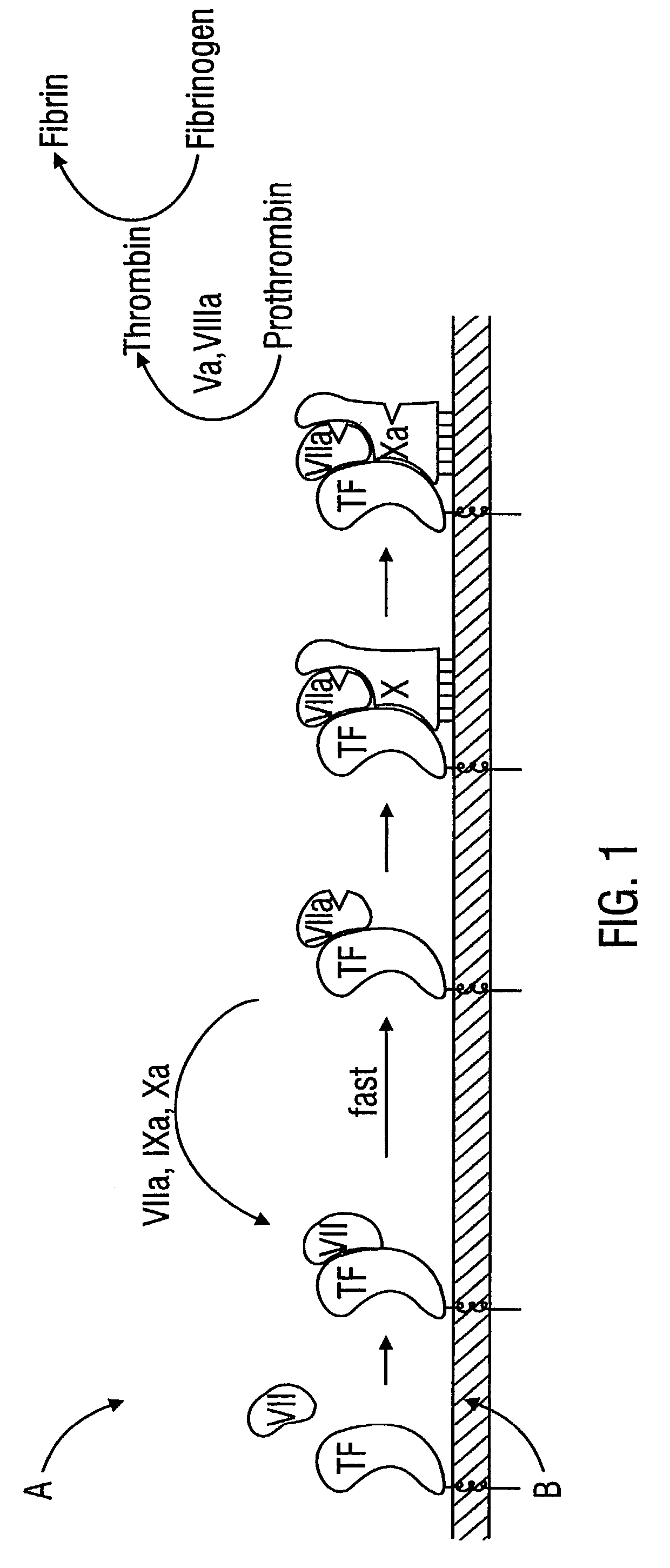Combined tissue factor methods for coagulation and tumor treatment
- Summary
- Abstract
- Description
- Claims
- Application Information
AI Technical Summary
Benefits of technology
Problems solved by technology
Method used
Image
Examples
example i
Synthesis of Truncated Tissue Factor
[0561]tTF is herein designated as the extracellular domain of the mature Tissue Factor protein (amino acid 1–219 of the mature protein; SEQ ID NO:1). SEQ ID NO:1 is encoded by, e.g., SEQ ID NO:10.
A. H6[tTF]
[0562]H6 Ala Met Ala[tTF]. The tTF complimentary DNA (cDNA) was prepared as follows: RNA from J-82 cells (human bladder carcinoma) was used for the cloning of tTF. Total RNA was isolated using the GlassMax™ RNA microisolation reagent (Gibco BRL). The RNA was reverse transcribed to cDNA using the GeneAmp RNA PCR kit (Perkin Elmer). tTF cDNA was amplified using the same kit with the following two primers:
[0563]
5′ primer:5′GTC ATG CCA TGG CCT CAG GCA CTA CAA(SEQ ID NO:15)3′ primer:5′TGA CAA GCT TAT TCT CTG AAT TCC CCT TTC T(SEQ ID NO:16)
[0564]The underlined sequences codes for the N-terminus of tTF. The rest of the sequence in the 5′ primer is the restriction site for NcoI allowing the cloning of tTF into the expression vector. The sequence in the ...
example ii
Synthesis of Dimeric Tissue Factor
[0573]The inventors' reasoned that Tissue Factor dimers may be more potent than monomers at initiating coagulation. It is possible that native Tissue Factor on the surface of J82 bladder carcinoma cells may exist as a dimer (Fair et al., 1987). The binding of one Factor VII or Factor VIIa molecule to one Tissue Factor molecule may also facilitate the binding of another Factor VII or Factor VIIa to another Tissue Factor (Fair et al., 1987; Bach et al., 1986). Furthermore, Tissue Factor shows structural homology to members of the cytokine receptor family (Edgington et al., 1991) some of which dimerize to form active receptors (Davies and Wlodawer, 1995). The inventors therefore synthesized TF dimers, as follows. While the synthesis of dimers hereinbelow is described in terms of chemical conjugation, recombinant and other means for producing the dimers of the present invention are also contemplated by the inventors.
A. [tTF] Linker [tTF]
[0574]The Gly [t...
example iii
Synthesis of Tissue Factor Mutants
[0589]Three tTF mutants are described that lack the capacity to convert tTF-bound Factor VII to Factor VIIa. There is 300-fold less Factor VIIa in the plasma compared with Factor VII (Morrissey et al., 1993). Therefore, circulating mutant tTF should be less able to initiate coagulation and hence exhibit very low toxicity. However, once the mutant tTF has localized to the tumor site, as is surprisingly demonstrated herein, Factor VIIa may be injected to exchange with the tTF-bound Factor VII. The mutated proteins have the sequences shown in SEQ ID NO:8 and SEQ ID NO:9 and are active in the presence of Factor VIIa.
A. [tTF]G164A
[0590]The “[tTF]G164A” has the mutant protein structure with the amino acid 164 (Gly) of tTF219 being replaced by Ala. The Chameleon double-stranded site directed mutagenesis kit (Stratagene) was used for generating the mutant. The DNA template is Gly[tTF] DNA and the sequence of the mutagenizing primer is:[0591]5′ CAA GTT CAG C...
PUM
| Property | Measurement | Unit |
|---|---|---|
| Length | aaaaa | aaaaa |
| Biological properties | aaaaa | aaaaa |
| Coagulation enthalpy | aaaaa | aaaaa |
Abstract
Description
Claims
Application Information
 Login to View More
Login to View More - R&D
- Intellectual Property
- Life Sciences
- Materials
- Tech Scout
- Unparalleled Data Quality
- Higher Quality Content
- 60% Fewer Hallucinations
Browse by: Latest US Patents, China's latest patents, Technical Efficacy Thesaurus, Application Domain, Technology Topic, Popular Technical Reports.
© 2025 PatSnap. All rights reserved.Legal|Privacy policy|Modern Slavery Act Transparency Statement|Sitemap|About US| Contact US: help@patsnap.com



